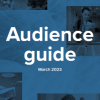Explanation: Mosaic
Contents
- A: CITY PROSPERITY
- B: PRESTIGE POSITIONS
- C: COUNTRY LIVING
- D: RURAL REALITY
- E: SENIOR SECURITY
- F: SUBURBAN STABILITY
- G: DOMESTIC SUCCESS
- H: ASPIRING HOMEMAKERS
- I: FAMILY BASICS
- J: TRANSIENT RENTERS
- K: MUNICIPAL TENANTS
- L: VINTAGE VALUE
- M: MODEST TRADITIONS
- N: URBAN COHESION
- O: RENTAL HUBS
Topics
Mosaic is a consumer segmentation model designed by Experian
Mosaic is a cross-channel consumer classification system which segments the population into 15 groups and 66 types that helps you to understand an individual's likely customer behaviour. You can find out more about the data behind Mosaic here.
Our bespoke profiling tool Audience Spectrum segments the whole UK population by their attitudes towards culture, and by what they like to see and do. There are 10 different Audience Spectrum profiles that you can use to understand who lives in your local area, what your current audiences are like, and what you could do to build new ones. Audience Spectrum is the most accurate tool the sector has ever had to help target audiences, and include a wider public.
A: CITY PROSPERITY
High status city dwellers living in central locations and pursuing careers with high rewards.
City Prosperity work in high status positions. Commanding substantial salaries they are able to afford expensive urban homes. They live and work predominantly in London, with many found in and around the City or in locations a short commute away. Well-educated, confident and ambitious, this elite group is able to enjoy their wealth and the advantages of living in a world-class capital to the full.
- A01 World-Class Wealth: Global high flyers and moneyed families living luxurious lifestyles in London's most exclusive boroughs.
- A02 Uptown Elite: High status households owning elegant homes in accessible inner suburbs where they enjoy city life in comfort.
- A03 Penthouse Chic: City professionals renting premium-priced flats in prestige central locations.
- A04 Metro High-Flyers: Career-minded 20 and 30-somethings renting expensive apartments in highly commutable areas of major cities.
B: PRESTIGE POSITIONS
Established families in large detached homes living upmarket lifestyles.
Prestige Positions are affluent married couples whose successful careers have afforded them financial security and a spacious home in a prestigious and established residential area. While some are mature empty-nesters or elderly retired couples, others are still supporting their teenage or older children.
- B05 Premium Fortunes: Asset-rich families with substantial income, established in distinctive, expansive homes in wealthy enclaves.
- B06 Diamond Days: Retired residents in sizeable homes whose finances are secured by significant assets and generous pensions.
- B07: Alpha Families: High-achieving families living fast-track lives, advancing careers, finances and their school-age kids' development.
- B08: Bank of Mum and Dad: Well-off families in upmarket suburban homes where grown-up children benefit from continued financial support.
- B09: Empty-Nest Adventure: Mature couples in comfortable detached houses who have the means to enjoy their empty-nest status.
C: COUNTRY LIVING
Well-off owners in rural locations enjoying the benefits of country life.
Country Living are well-off homeowners who live in the countryside often beyond easy commuting reach of major towns and cities. Some people are landowners or farmers, others run small businesses from home, some are retired and others commute distances to professional jobs.
- C10 Wealthy Landowners: Prosperous owners of country houses affluent families, successful farmers and second-home owners.
- C11 Rural Vogue: Country-loving families pursuing a rural idyll in comfortable village homes, many commuting some distance to work.
- C12 Scattered Homesteads: Older households appreciating rural calm in stand-alone houses within agricultural landscapes.
- C13 Village Retirement: Retirees enjoying pleasant village locations with amenities to service their social and practical needs.
D: RURAL REALITY
Householders living in inexpensive homes in village communities.
Rural Reality are people who live in rural communities and generally own their relatively low cost homes. Their moderate incomes come mostly from employment with local firms or from running their own small business.
- D14 Satellite Settlers: Mature households living in developments around larger villages with good transport links.
- D15 Local Focus: Rural families in affordable village homes who are reliant on the local economy for jobs.
- D16 Outlying Seniors: Pensioners living in inexpensive housing in out of the way locations.
- D17 Far-Flung Outposts: Inter-dependent households living in the most remote communities with long travel times to larger towns.
E: SENIOR SECURITY
Elderly people with assets who are enjoying a comfortable retirement.
Senior Security are elderly singles and couples who are still living independently in comfortable homes that they own. Property equity gives them a reassuring level of financial security. This group includes people who have remained in family homes after their children have left, and those who have chosen to downsize to live among others of similar ages and lifestyles.
- E18 Legacy Elders: Financially-secure elders on good pensions, now mostly living alone in comfortable suburban homes.
- E19 Bungalow Haven: Peace-seeking seniors appreciating the calm of bungalow estates designed for older owners.
- E20 Classic Grandparents: Lifelong couples in standard suburban homes, often enjoying retirement through grandchildren and gardening.
- E21 Solo Retirees: Senior singles owning affordable but pleasant homes, whose reduced income are satisfactory.
F: SUBURBAN STABILITY
Mature suburban owners living settled lives in mid-range housing.
Suburban Stability are typically mature couples or families, some enjoying recent empty-nest status and others with older children still at home. They live in mid-range family homes in traditional suburbs where they have been settled for many years.
- F22 Boomerang Boarders: Long-term couples with mid-range incomes whose adult children have returned to the shelter of the family home.
- F23 Family Ties: Active families with adult children and some teens, giving prolonged support to the next generation.
- F24 Fledgling Free: Pre-retirement couples enjoying greater space and reduced commitments since their children left home.
- F25 Dependable Me: Single mature owners settled in traditional suburban homes working in intermediate occupations.
G: DOMESTIC SUCCESS
Thriving families who are busy bringing up children and following careers.
Domestic Success are high-earning families who live affluent lifestyles in upmarket homes situated in sought after residential neighbourhoods. Their busy lives revolve around their children and successful careers in higher managerial and professional roles.
- G26 Cafés and Catchments: Affluent families with growing children living in upmarket housing in city environs.
- G27 Thriving Independence: Well-qualified older singles with incomes from successful professional careers in good quality housing.
- G28 Modern Parents: Busy couples in modern detached homes juggling the demands of school-age children and careers.
- G29 Mid-Career Convention: Professional families with children in traditional mid-range suburbs where neighbours are often older.
H: ASPIRING HOMEMAKERS
Younger households settling down in housing priced within their means.
Aspiring Homemakers are younger households who have, often, only recently set up home. They usually own their homes in private suburbs, which they have chosen to fit their budget.
- H30 Primary Ambitions: Families with school-age children, who have bought the best house they can afford within popular neighbourhoods.
- H31 Affordable Fringe: Settled families with children owning modest, 3-bed semis in areas where there's more house for less money.
- H32 First-Rung Futures: Young owners settling into the affordable homes they have bought in established suburbs.
- H33 Contemporary Starts: Young families and singles setting up home in modern developments that are popular with their peers.
- H34 New Foundations: Occupants of brand new homes who are often younger singles or couples with children.
- H35 Flying Solo: Independent young singles on starter salaries choosing to rent homes in family suburbs.
I: FAMILY BASICS
Families with limited resources who have to budget to make ends meet.
Family Basics are families with children who have limited budgets and can struggle to make ends meet. Their homes are low cost and are often found in areas with fewer employment options.
- I36 Solid Economy: Stable families with children renting higher value homes from social landlords.
- I37 Budget Generations: Families providing lodgings for adult children and gaining the benefit of pooled resources.
- I38 Economical Families: Busy families with children who own their low-cost homes and budget carefully.
- I39 Families on a Budget: Families with children in low value social houses making limited resources go a long way.
J: TRANSIENT RENTERS
Single people privately renting low cost homes for the short term.
Transient Renters are single people who pay modest rents for low cost homes. Mainly younger people, they are highly transient, often living in a property for only a short length of time before moving on.
- J40 Value Rentals: Younger singles and couples, some with children, setting up home in low value rented properties.
- J41 Youthful Endeavours: Young people endeavouring to gain employment footholds while renting cheap flats and terraces.
- J42 Midlife Renters: Maturing singles in employment who are renting affordable homes for the short-term.
- J43 Renting Rooms: Transient renters of low cost accommodation often within older properties.
K: MUNICIPAL TENANTS
Urban renters of social housing facing an array of challenges.
Municipal Tenants are long-term social renters living in low-value multi-storey flats in urban locations, or small terraces on outlying estates. These are challenged neighbourhoods with limited employment options and correspondingly low household incomes.
- K44 Inner City Stalwarts: Long-term renters of inner city social flats who have witnessed many changes.
- K45 City Diversity: Households renting social flats in busy city suburbs where many nationalities live as neighbours.
- K46 High Rise Residents: Tenants of social flats in high rise blocks, often living alone.
- K47 Single Essentials: Singles renting small social flats in town centres.
- K48 Mature Workers: Older social renters settled in low value homes who are experienced at budgeting.
L: VINTAGE VALUE
Elderly people reliant on support to meet financial or practical need.
Vintage Value are elderly people who mostly live alone, either in social or private housing, often built with the elderly in mind. Levels of independence vary, but with health needs growing and incomes declining, many require an increasing amount of support.
- L49 Flatlet Seniors: Ageing singles with basic income renting small flats in centrally located developments.
- L50 Pocket Pensions: Penny-wise elderly singles renting in developments of compact social homes.
- L51 Retirement Communities: Elderly living in specialised accommodation including retirement homes, villages and complexes.
- L52 Estate Veterans: Longstanding elderly renters of social homes who have seen neighbours change to a mix of owners and renters.
- L53 Seasoned Survivors: Single elderly who are long-term owners of their low value properties which provide some financial security.
M: MODEST TRADITIONS
Mature homeowners of value homes enjoying stable lifestyles.
Modest Traditions are older people living in inexpensive homes that they own, often with the mortgage nearly paid off. Both incomes and qualifications are modest, but most enjoy a reasonable standard of living. They are long-settled residents having lived in their neighbourhoods for many years.
- M54 Down-to-Earth Owners: Ageing couples who have owned their inexpensive home for many years while working in routine jobs.
- M55 Back with the Folks: Older owners whose adult children are sharing their modest home while striving to gain independence.
- M56 Self Supporters: Hard-working mature singles who own their budget houses and earn modest wages.
N: URBAN COHESION
Residents of settled urban communities with a strong sense of identity.
Urban Cohesion are settled extended families and older people who live in multi-cultural city suburbs. Most have bought their own homes and have been settled in these neighbourhoods for many years, enjoying the sense of community they feel there.
- N57 Community Elders: Established older households owning city homes in diverse neighbourhoods.
- N58 Culture & Comfort: Thriving families with good incomes in diverse suburbs.
- N59 Large Family Living: Large families living in traditional terraces in neighbours with a strong community identity.
- N60 Ageing Access: Older residents owning small inner suburban properties with good access to amenities.
O: RENTAL HUBS
Educated young people privately renting in urban neighbourhoods.
Rental Hubs contains predominantly young, single people in their 20s and 30s who live in urban locations and rent their homes from private landlords while in the early stages of their careers, or pursuing studies.
- O61 Career Builders: Professional singles and couples in their 20s and 30s progressing in their field of work from commutable properties.
- O62 Central Pulse: City-loving youngsters renting city centre flats in vibrant locations close to jobs and night life.
- O63 Flexible Workforce: Successful young renters ready to move to follow worthwhile incomes from service sector jobs.
- O64 Bus-Route Renters: Singles renting affordable private flats further away from central amenities and often on main roads.
- O65 Learners & Earners: Inhabitants of the university fringe where students and older residents mix in cosmopolitan locations.
- O66 Student Scene: Students living in high density accommodation close to universities and educational centres.
Our bespoke profiling tool Audience Spectrum segments the whole UK population by their attitudes towards culture, and by what they like to see and do. There are 10 different Audience Spectrum profiles that you can use to understand who lives in your local area, what your current audiences are like, and what you could do to build new ones. Audience Spectrum is the most accurate tool the sector has ever had to help target audiences, and include a wider public.
Related Guides
- Boost Your Email Marketing with Audience Spectrum - a step by step guide
- How to use Audience Spectrum to Enhance your Funding Applications
- How to Use Audience Spectrum to Inform Your Programme and Engage with Diverse Audiences
- How to use Audience Spectrum to Target Paid Online Advertising
- How to use the Audience Spectrum Segments in your Catchment Area chart on your Overview Dashboard
- Segmentation made simple
- Using Audience Spectrum Subsegments | Speak your benefactors' language
- Using Audience Spectrum Subsegments | Upsell your add-ons more effectively
- Top Tips | Using the Audience Spectrum Subsegments
- Using Audience Spectrum Subsegments | Get personal with your profiling
- Using Audience Spectrum Subsegments | Access your underserved audiences
- How understanding audience segmentation can inform your website user experience
- What is the Audience Spectrum Enhancement in Spektrix, and how does it work?
- How to get started with applying Audience Spectrum attributes to your Spektrix reports
- Using Audience Spectrum strategically as a customer attribute in Spektrix
- Creating and improving dynamic content in Spektrix using Audience Spectrum
- Explanation: Index
- An introduction to indexes
- KPIs for audiences: a practical guide
- Meaningful mapping
- An introduction to benchmarking
Related Questions
- How do I get set up with the Audience Spectrum Enhancement for Spektrix?
- I have an Audience Spectrum license: why are some of my customer records profiled as ‘Unclassified’ & ‘Unmatched.’
Case Studies
-
 Audience Spectrum in Action | Securing Funding for a Circus Festival
Audience Spectrum in Action | Securing Funding for a Circus Festival
-
 Audience Spectrum in Action | Aberdeen Performing Arts
Audience Spectrum in Action | Aberdeen Performing Arts
-
 Audience Spectrum in Action | London & Culture Calling Arts
Audience Spectrum in Action | London & Culture Calling Arts
-
 Audience Spectrum in Action | Theatr Brycheiniog
Audience Spectrum in Action | Theatr Brycheiniog
-
 How Audience Spectrum helped support Nottingham Playhouse's Levelling Up Strategy
How Audience Spectrum helped support Nottingham Playhouse's Levelling Up Strategy
-
 Looking ahead at Hall for Cornwall
Looking ahead at Hall for Cornwall
-
 Using Audience Spectrum to drive culture change and a major audience development programme
Using Audience Spectrum to drive culture change and a major audience development programme
-
 Audience Spectrum in Action | Edinburgh International Festival
Audience Spectrum in Action | Edinburgh International Festival
-
 Shakespeare North Playhouse: Audience development using Audience Spectrum as a catalyst and tool
Shakespeare North Playhouse: Audience development using Audience Spectrum as a catalyst and tool
